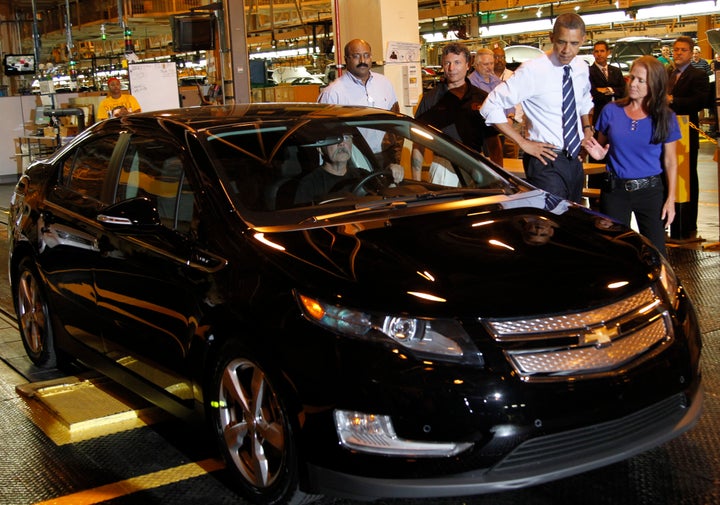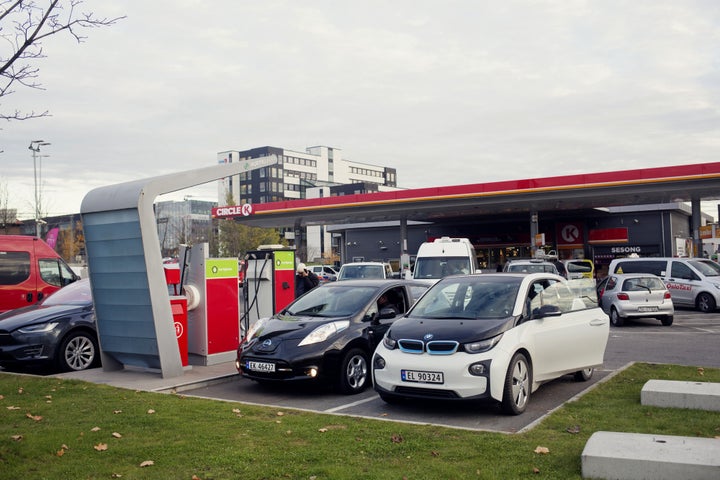General Motors just killed the best car you’ve never owned.
I am talking about the Chevy Volt, a plug-in hybrid GM has been producing since 2010. GM is idling the Detroit-Hamtramck plant that builds Volts and ending the car’s production altogether, the company announced on Monday. The last Volt will roll off the line in March.
The announcement was not a surprise. Sales never met expectations. Rumors about the end of the Volt had been circulating for months. Although workers said they got no warning about the plant closure, GM was following the lead of Ford, which announced cutbacks of its own a few months ago.
As always, the decision reflects a variety of factors, including a slowing economy likely to reduce sales next year. All of the factories slated to go dormant are operating well below capacity. And, at least in theory, the decision does not mean GM has lost interest in electric vehicles.
On the contrary, the Hamtramck plant idling is part of a larger downsizing that will include four other North American plants and reduce the company’s total workforce by more than 14,000. One of those plants is Ohio’s Lordstown facility, where workers produce the Cruze, a gas-only sedan that uses the same platform as the Volt and that GM will also stop producing next year.

GM officials say a major reason to trim its factories and workforce now is to prepare for a future with more electric vehicles, along with automated vehicles and car-sharing. The production of electric vehicles requires factories with different facilities and, ultimately, workers with different skills. Even now, the company points out, it is hiring programmers to develop new-generation vehicles.
It’s impossible to know how seriously to take this explanation ― to tell whether GM is really making a long-term bet on hybrids and plug-ins, or simply shedding production lines that are less profitable, for the moment, in order to make money for today’s executives and shareholders. But it would certainly be in society’s interest for GM to be thinking about the future in the way that it claims.
A stronger commitment to electric vehicles would mean the company intends to invest in new facilities and hire more workers ― ideally, many of the same ones about to lose their jobs, thus sparing them and their communities from serious pain. It would also mean the company is committing to cars and trucks that spew less carbon into the atmosphere, at a time when climate change is literally destroying lives every day.
But count this Volt owner skeptical, given what I’ve seen happen in Detroit and Washington ― and even what I have seen at my local car dealer when we went to buy ours.
Fast, Whisper Quiet, And Almost Never Needs Gas
We first looked at the Volt in 2015. We already had a larger vehicle for hauling kids and wanted something smaller, and more fuel efficient, as a second car. An electric car sounded appealing, but we suffered from “range anxiety.” In other words, we worried about running out of charge in the middle of a drive, especially with the lack of widely available charging stations.
The Volt, it turns out, was designed for people like us. It has a battery as well as a traditional engine, operating on the battery alone until it has no more charge and then switching over to normal hybrid operation.
The weight of the combustion machinery and gas means the battery can’t be too big, and in the early models that limited pure-electric range to between 26 and 41 miles, depending on outside temperature because battery strength is highly sensitive to cold. But we would be using the car primarily for short drives, and even in hybrid mode we would be getting around 40 miles per gallon, or better depending on usage, which was way better than in our previous car.

We knew all of this going into the showroom. What we didn’t know until the test drive was how much fun we would have behind the wheel. The Volt was peppy and surprisingly roomy for such a small vehicle. The sound system was terrific and, when in pure electric mode, it was whisper quiet. The insulation was good enough to keep road noise at a minimum, which meant we could hear each other without shouting ― or listen to music without cranking the volume.
We signed up for a three-year lease, making what still feels the best car decision of my life. The car performed as promised, and sometimes we would go months without buying gas. It spent not a single a day in the shop, except for routine oil changes and tire rotations. When the lease was up this year, we got a new one. So far, it’s given us the same performance but, thanks to improved battery capacity, the range reaches 53 miles in warm weather.
If it sounds like I’m a bit evangelical about the Volt, that’s because I am ― and that is entirely typical of Volt owners, who have built a community online where they love to swap stories of maximizing their battery range or the fun of driving in the fast-acceleration sport mode. The community includes a source of mine, a former federal and state public health official now on the faculty at a prominent university. On the phone we talk Volt performance, then policy.
Sales Were A Problem From The Beginning
The enthusiasm of Volt owners undoubtedly has something to do with their ― er, our ― priors. People buying the Volt are, by and large, people who get excited about transportation technology, saving the planet, or both. But automotive experts are similarly effusive about the car and have been from the beginning. It won North American Car of the Year in 2011.
Still, sales lagged, badly ― and GM’s marketing, or lack thereof, almost surely had something to do with that. The Volt got a ton of media attention when it debuted and President Barack Obama touted it after his administration rescued GM from collapse. But GM never put money into advertising and that attitude filtered down the dealer level.
The first time we looked at a Volt, our sales representative didn’t even understand the car. We had to explain to him how the battery and combustion engine worked in tandem. On the first test drive, he insisted the battery had full charge when in fact it had none. The car was running in hybrid mode.
This last time, a few months ago, our salesman was more knowledgeable. But everything about the dealership ― from the posters on the walls to the incentives available to consumers ― made it clear they really wanted to sell us a crossover, SUV, or truck.
It’s no big secret why. Carmakers make a lot more money on those big vehicles and, lately, that is what consumers have wanted. And while consumer preferences reflect a bunch of factors, a big one is price ― in particular, the price of gasoline.
“As long as gas prices remain stable, it appears that the market wants more trucks, SUVs and crossovers and less midsize/full-size sedans and compact cars,” Matt DeLorenzo, senior managing editor for Kelley Blue Book, told HuffPost.
Cheap Gas Distorts The Car Market And Poisons The Planet
This is where government policy becomes part of the story.
Gas is cheap and has been for a while. But that is only because its price is mostly a function of what it costs to drill, refine, and distribute petroleum. It doesn’t account for the long-term costs of spewing all that extra carbon into the air ― costs that, as last week’s national report on climate showed yet again, society is already bearing in some very painful ways.
The most direct way to address this would be to tax carbon, ideally in a way that simultaneously protects lower-income people and those who depend on transportation for a living from financial harm. This is what European nations do with their high gas taxes and it’s one reason consumers there opt for smaller, more fuel-efficient cars ― and are likely to embrace electric vehicles more quickly than American consumers will.
Another way to change the cost calculus is to subsidize either the production or purchase of electric vehicles. It’s less equitable because higher-income households get more benefit, but it does promote ownership. Tax credits of up to $7,500 per car are available now, thanks to a program that started under President George W. Bush and got much bigger under Obama, who also plowed billions into the development of green technology, including automotive, as part of the Recovery Act.

But those tax credits end once carmarkers have sold 200,000 vehicles that qualify, and today’s Republicans have shown no interest in renewing them, let alone increasing them. In fact, some have proposed shutting down the credits early ― even as other countries are supporting hybrid and plug-in vehicles a lot more aggressively.
“Look at Norway, they’ve subsidized the purchase of electric vehicles,” Kristin Dziczek, vice president at the Michigan-based Center for Automotive Research, said on Monday. “I haven’t seen so many in my damn life.”
She’s right. Electrics and hybrids now account for half of all new car sales there.
The other, final way to boost sales of electric vehicles is to tighten mileage standards. That’s another step that the Obama administration undertook and, not at all surprisingly, it’s a step that the Trump administration is trying to reverse.
Electric Vehicles Still Have A Future, If We Want It
The administration may not succeed. California officials, who have a long history of acting on their own to demand more efficient and environmentally friendly vehicles, now require that electric vehicles account for a portion of each manufacturer’s sales. Nine other states, with officials similarly focused on climate change, have adopted the standards.
The system involves a complex scheme of tradable credits. Companies that don’t hit their targets can buy the credits from companies that do, and cars that rely more heavily or exclusively on electric power get larger credit than hybrids that still use gas.
That may be one reason GM is stopping Volt production, auto industry experts told me Monday. The company wants to put all of its efforts into the Bolt, a smaller and cheaper all-electric vehicle that gets similar raves from owners.

That would not be the worst outcome, especially if GM can put production of the Bolt or some other, newer-generation electric vehicles into the plants it is about to idle. That can even include crossovers, which can still run on electricity and, if smaller, run quite efficiently.
These possibilities will undoubtedly be topics at the company’s negotiations next year with the United Auto Workers, which will be pushing to get those plants back online and those workers back on the payroll.
Still, the shift to electric vehicles would seem a lot more likely, and go a lot more smoothly, if the carmakers and policymakers would push for it consistently. So far, they haven’t. The Volt in my garage is proof of what American engineering can accomplish, but it takes more than engineering to sell a car ― even one that could help save the planet.
